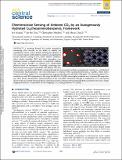Chemiresistive Sensing of Ambient CO2 by an Autogenously Hydrated Cu3(hexaiminobenzene)2 Framework
Author(s)
Stassen, Ivo; Dou, Jinhu; Hendon, Christopher; Dinca, Mircea
DownloadPublished version (1.859Mb)
Terms of use
Metadata
Show full item recordAbstract
A growing demand for indoor atmosphere monitoring relies critically on the ability to reliably and quantitatively detect carbon dioxide. Widespread adoption of CO2 sensors requires vastly improved materials and approaches because selective sensing of CO2 under ambient conditions, where relative humidity (RH) and other atmosphere contaminants provide a complex scenario, is particularly challenging. This report describes an ambient CO2 chemiresistor platform based on nanoporous, electrically conducting two-dimensional metal-organic frameworks (2D MOFs). The CO2 chemiresistive sensitivity of 2D MOFs is attained through the incorporation of imino-semiquinonate moieties, i.e., well-defined N-heteroatom functionalization. The best performance is obtained with Cu3(hexaiminobenzene)2, Cu3HIB2, which shows selective and robust ambient CO2 sensing properties at practically relevant levels (400-2500 ppm). The observed ambient CO2 sensitivity is nearly RH-independent in the range 10-80% RH. Cu3HIB2 shows higher sensitivity over a broader RH range than any other known chemiresistor. Characterization of the CO2-MOF interaction through a combination of in situ optical spectroscopy and density functional theory calculations evidence autogenously generated hydrated adsorption sites and a charge trapping mechanism as responsible for the intriguing CO2 sensing properties of Cu3HIB2. Keywords: Sensors; Adsorption; Metal organic frameworks; Electrical conductivity; Materials
Date issued
2019-06Department
Massachusetts Institute of Technology. Department of ChemistryPublisher
American Chemical Society (ACS)
Citation
Stassen, Ivo et al. "Chemiresistive Sensing of Ambient CO2 by an Autogenously Hydrated Cu3(hexaiminobenzene)2 Framework." ACS Central Science 5, 8 (August 2019): 1425–1431 ©2019 American Chemical Society.
Version: Final published version
ISSN
2374-7943
2374-7951